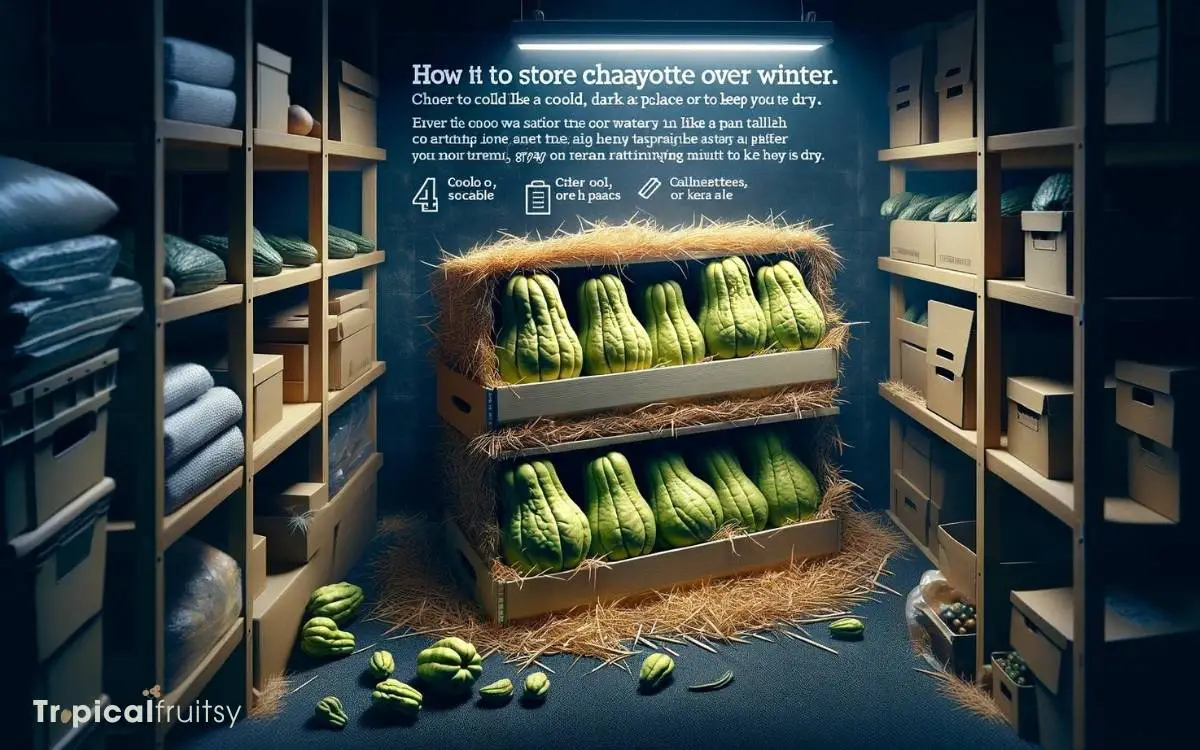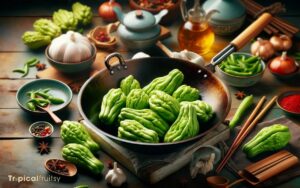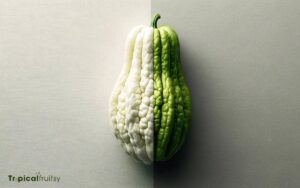How to Store Chayote Over Winter? 6 Easy Steps!
Storing chayote, or mirliton, over winter requires careful preparation to maintain its freshness. Mature and undamaged chayotes should be kept in a cool, well-ventilated area with moderate humidity.
Employing methods like refrigeration or freezing can extend chayote’s shelf life, ensuring it stays fresh for culinary use throughout the winter.
To store chayotes successfully during winter, follow these steps:
Preserve chayote’s freshness over winter with proper storage techniques for delightful dishes even in the cold months.

Key Takeaway
Step 1: Selecting the Best Chayotes
Optimal preservation begins with the careful selection of chayotes, ensuring longevity and quality during winter storage.
To identify specimens best suited for extended storage, one must examine the chayote’s exocarp, or outer skin, for uniformity in color and absence of blemishes, which can indicate premature degradation.
Chayotes should be firm to the touch, with a slight give that denotes ripeness without over-maturity; an excessively soft texture may lead to rapid spoilage.
Furthermore, the peduncle, or stem end, should be intact and dry; a moist peduncle can harbor microbial growth, compromising the fruit’s structural integrity.
Proper initial selection is paramount, as it significantly influences the success of subsequent preservation methodologies and the overall shelf life of the chayote.
Step 2: Ideal Storage Conditions
Regarding chayote preservation, establishing a cool, well-ventilated, and dark environment is crucial for maintaining their freshness throughout the winter months.
Optimal storage conditions mitigate the risk of decay and sprouting, which are common issues with improperly stored produce. It is essential to maintain a consistent climate to ensure the longevity of the chayote.
Adhering to the following parameters will enhance their preservation:
- Temperature: Keep the storage area at a steady 7.5-10°C (45-50°F).
- Humidity: Aim for a relative humidity level of 50-60%, to prevent dehydration and shrinkage.
- Ventilation: Ensure proper air circulation to avoid accumulation of ethylene gas and moisture.
- Darkness: Protect chayote from light exposure to prevent greening and the development of solanine.
Step 3: Preparing Chayote for Storage
Prior to storage, it is imperative to cleanse chayote fruit meticulously to mitigate the risk of spoilage caused by residual contaminants.
Ensuring the chayote is dry post-cleansing will further prevent the proliferation of mold and bacteria during the storage period.
Establishing and maintaining an optimal temperature is critical for prolonging the fruit’s freshness and viability throughout the winter months.
Clean Thoroughly
Before storing chayote for the winter, it is essential to clean each fruit meticulously to prevent spoilage and extend its shelf life.
Proper cleaning not only removes surface dirt and potential pathogens but also ensures that the chayote is in its best condition for storage.
Follow these steps:
- Rinse each chayote under cool, running water to remove any loose soil or debris.
- Use a soft brush to gently scrub the surface, ensuring all crevices are reached without damaging the skin.
- Pat the chayote dry with a clean, absorbent towel to remove excess moisture.
- Inspect each fruit for signs of damage or decay and set aside any that are not suitable for long-term storage.
Understanding the importance of a dry and clean chayote, we now turn our attention to maintaining the optimal temperature setting for its preservation.
Optimal Temperature Setting
To ensure the longevity of chayote during winter storage, maintain a constant temperature between 50-59 degrees Fahrenheit (10-15 degrees Celsius).
This temperature range is critical as it inhibits the growth of decay-causing pathogens while still preventing the chayote from becoming subject to chilling injury, which occurs at temperatures below 50 degrees Fahrenheit (10 degrees Celsius).
It is essential to use a calibrated thermometer to monitor the storage environment accurately. Temperature fluctuations can lead to condensation, which promotes mold growth and accelerates spoilage.
Therefore, storage facilities must be equipped with stable, well-regulated climate control systems to ensure the optimal temperature is consistently maintained.
This precise temperature control will contribute significantly to preserving the chayote’s quality and extending its shelf life throughout the winter months.
Step 4: Storing Chayote in a Cellar
Place chayotes in a single layer on a shelf or in a crate when storing them in a cellar to ensure proper air circulation and prevent rotting.
The humidity and temperature within a cellar are pivotal for the preservation of chayotes throughout the winter months.
Here are key steps to follow:
- Maintain a consistent cellar temperature between 50-60°F (10-15.6°C), which is ideal for chayote storage.
- Ensure relative humidity levels are around 85-95%, to keep the chayotes hydrated without promoting mold growth.
- Inspect the chayotes regularly for any signs of spoilage, such as soft spots or mold, and remove affected fruits promptly.
- Avoid storing chayotes near ethylene-producing fruits, as this can accelerate their ripening and potentially lead to spoilage.
Step 5: Refrigeration Versus Freezing
When considering the preservation of chayote squash during colder months, refrigeration and freezing present two distinct methodologies, each affecting texture preservation and shelf life differently.
Refrigeration at temperatures just above 0°C can maintain the vegetable’s firmness but may only extend shelf life to a few weeks.
In contrast, freezing chayote at temperatures below -18°C can prolong edibility for months, albeit with potential alterations to its textural integrity upon thawing.
Texture Preservation
Maintaining the crisp texture of chayote throughout the winter requires careful consideration of storage methods, particularly when choosing between refrigeration and freezing.
When preserving the texture of chayote, consider the following:
- Refrigeration: Store chayote at a constant 7-10°C to minimize moisture loss and maintain firmness.
- Humidity Control: Keep relative humidity at 80-90% to prevent dehydration and wrinkling of the skin.
- Ventilation: Ensure proper airflow to prevent ethylene accumulation, which can lead to premature spoilage.
- Freezing: While freezing can extend shelf life, it may result in textural changes due to ice crystal formation within the chayote’s cells.
With these considerations in mind, one can optimize texture preservation.
Shelf Life Extension
Extending the shelf life of chayote during winter months involves a strategic choice between refrigeration and freezing, each with its own set of benefits and limitations.
Refrigeration at temperatures of 45-50°F can maintain the chayote’s freshness for approximately 2-4 weeks.
The vegetable should be stored unwashed in a plastic bag with perforations to allow for adequate airflow, thus preventing moisture accumulation and subsequent rotting.
Freezing, on the other hand, can extend the chayote’s shelf life to about 8 months. However, it necessitates blanching to inhibit enzyme activity that causes flavor and texture degradation.
Freezing must be done at 0°F, with the chayote sealed in airtight containers or freezer bags. This method, while more extensive, can alter the texture, making it more suitable for cooked applications post-thawing.
Step 6: Monitoring and Using Stored Chayote
Chayote longevity hinges on consistent monitoring and timely consumption to prevent spoilage during winter storage.
For optimal results, adhere to the following guidelines:
- Inspect Weekly: Examine each chayote for signs of decay, such as softened areas or mold. Remove affected specimens promptly to forestall cross-contamination.
- Control Environment: Maintain stable temperature and humidity levels within recommended parameters to minimize the risk of spoilage.
- Rotate Stock: Utilize a first-in, first-out system, consuming the oldest stored produce first to ensure freshness and reduce waste.
- Prepare Accordingly: When using chayote, handle with care to avoid bruising. Cook thoroughly to maximize flavor and nutritional value.
Adhering to these practices will ensure the chayote remains a viable and enjoyable food source throughout the winter season.
Conclusion
The conservation of chayote through the winter months mirrors the preservation of knowledge across ages.
Just as the proper storage of this gourd requires meticulous attention to temperature, humidity, and handling, so too does the safeguarding of information demand precise archiving techniques.
In both realms, the meticulous stewardship of resources ensures that they remain available and useful for future generations, reflecting the broader principle that careful preservation underpins enduring utility.






